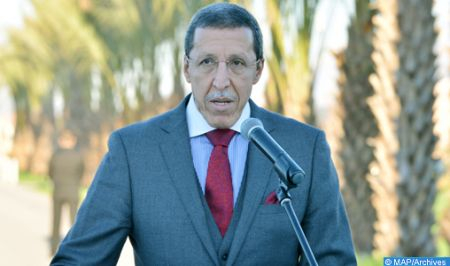Hilale: UN Parameters for Self-determination Not Predictable in Moroccan Sahara
Before the Committee of 24 of the UN General Assembly, Ambassador Omar Hilale, Permanent Representative of Morocco to the United Nations, stressed Monday that the UN parameters of self-determination are by no means predictable in Moroccan Sahara. “Since the signing of the Madrid Agreement on November 14, 1975, the principle of self-determination as advocated by Chapter XI of the UN Charter, has definitely ceased to apply to the Moroccan Sahara,” said Hilale in a speech before the Committee. In this regard, the Moroccan diplomat stressed that the parameters laid down by the founding resolutions of self-determination, namely 1514 and 1541, notably that the territory must be “geographically separate and ethnically or culturally distinct from the country that administers it are in no way predicable in the Moroccan Sahara,” adding that “none of these requirements is opposable to the Moroccan Sahara”. To this end, Hilale explained that: 1- The Sahara is not geographically separated from Morocco. The Sahara is the natural continuity of the Kingdom. Laayoune, Smara, Bir Lahlou, Tifariti, Dakhla or Guergarat are territorially linked to Sidi Ifni, Goulmime, Tarfaya and other regions of the Kingdom. These cities are not separated by a sea or a river, nor by thousands of kilometers. 2- The tribal and ethnic components of the Moroccan Sahara region are the same as those of the north of the Kingdom. The tribes in Laayoune and Dakhla are the same as in Sidi Ifni and Tarfaya. Moreover, due to their nomadic lifestyle, the extension of these tribes is also found in the neighboring countries. 3- The population of the Moroccan Sahara has the same religion as the rest of the Kingdom: Islam. The prayers in the mosques were done in the name of His Majesty the King, Commander of the Faithful, long before the Spanish occupation in Laayoune, Dakhla, Fez, Marrakech and Rabat. 4- Arabic and Hassani dialect are the mother tongues spoken in Laayoune and Dakhla as well as in Tan Tan and Zag. 5- The Hassanian culture is the heritage shared between the Sahara and the northern regions of the Kingdom. It is celebrated and protected as a national heritage throughout the Moroccan territory. The inapplicability of all these criteria to the Moroccan Sahara adds to the legal force, historical truths and political legitimacy, to attest, if it is still needed, that the Moroccan Sahara is neither a so-called decolonization issue, nor a subject of self-determination, and even less a so-called “non-self-governing territory”, insisted Ambassador Hilale, inviting the members of the Committee to make a simple comparison between the Moroccan Sahara and the territories on the C24 agenda, to see that there is no similarity with the situations of the 16 “non-self-governing territories”. Referring to the legal, political and historical arguments of the Moroccanness of the Sahara, Ambassador Hilale recalled that “the Sahara has always been an integral part of Morocco, and this long before its Spanish colonization in 1884. Even the name of so-called “Western Sahara” was given to it only after its occupation by Spain. During the colonial period, the Moroccan territory was divided into several zones of occupation by France, Spain and by several international powers as far as the city of Tangier was concerned”. He added that “Morocco has recovered its territorial integrity in stages and through international agreements negotiated with the various colonial powers. Thus, after having obtained its independence from France and recovered Tangier in 1956, Morocco engaged in negotiations with Spain, in accordance with the resolutions of the United Nations General Assembly, which led to the gradual recovery of the regions located in the south of the Kingdom, namely Tarfaya in 1958, Sidi Ifni in 1969 and finally Sakia-El-Hamra and Oued Eddahab, on November 14, 1975, according to the Madrid Agreement. This agreement was duly registered with the Secretary General of the United Nations on November 18, 1975 and validated by the General Assembly of the United Nations by its resolution 3458B of December 10, 1975”. Hilale also said that “the Moroccanness of the Sahara was also confirmed by the advisory opinion of the International Court of Justice, of October 16, 1975, which recognized that the Sahara was not terra-nullius at the time of its occupation by Spain and established the existence of legal and historical links of allegiance between the tribes of the Sahara and the Kings of Morocco”. “It is this allegiance of the Moroccan People to the Monarchy, from Tangier to Lagouira, rooted in the millennial history of the Kingdom of Morocco, which is the basis of Morocco’s sovereignty over all its territories, including its Sahara,” he stressed. Finally, Hilale said that “no reason would justify keeping the issue of the Moroccan Sahara on the agenda of this Committee, nor on that of the Fourth Committee. The Charter of our Organization has clearly established a separation between its bodies, with a clear distinction between their mandates. Thus, in accordance with Article 12 (1) of the UN Charter concerning the prerogatives of the General Assembly, the question of the Moroccan Sahara should be discussed exclusively in the Security Council. It is this principal body that has been seized of the matter since 1988, due to the failure of the mediation of the Organization of African Unity. The Security Council rightly examines it within the framework of Chapter VI of the United Nations Charter, relating to the peaceful settlement of disputes, and not as a so-called decolonization issue”.

